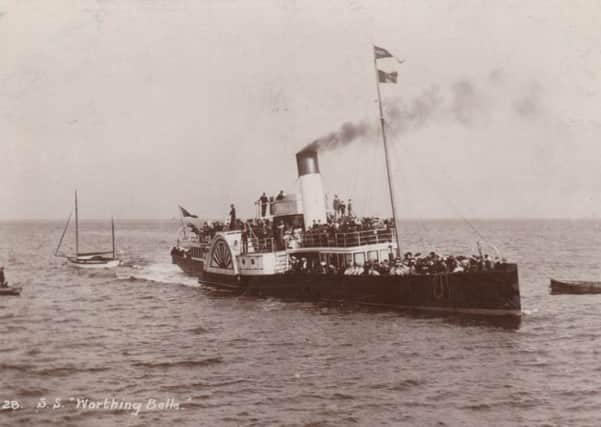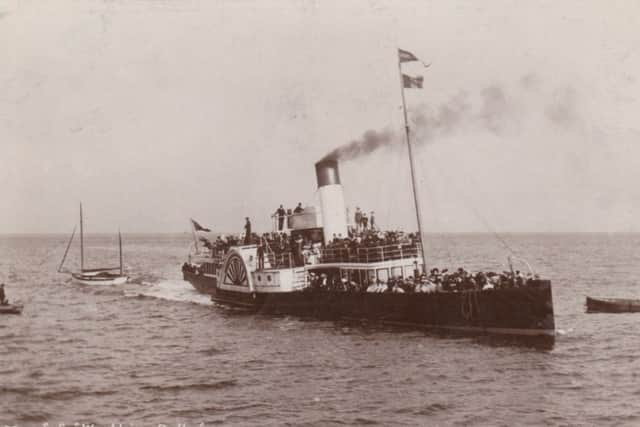‘Just a P. C. of the boat we went to Worthing in on Tuesday night’


Originally called Diana Vernon, she was one of a number of paddle steamers built for the company over a five-year period. She measured 180 feet in length and was coal-fired.
Others in the fleet included Meg Merrilies, Jeanie Deans and Lucy Ashton – all, like Diana Vernon, named after characters in the Waverley novels of Walter Scott.
Advertisement
Hide AdAdvertisement
Hide AdDiana Vernon served in the upper reaches of the Firth of Clyde, sailing from Craigendoran (now a suburb of Helensburgh) into Gare Loch and Holy Loch.


Then, in 1899, she was replaced by the newly-built Waverley, and two years later she was sold to Mr J. Lee of Shoreham-by-Sea, who renamed her Worthing Belle.
Worthing Belle’s “home port” was Brighton’s West Pier, from where she was employed on trips west to Worthing, Littlehampton and Bognor, and east to Eastbourne and Hastings, as well as on short excursions into the Channel.
In 1909, Worthing Belle was acquired by William Reid, whose grandson, Phil Hayden, still lives in Worthing.
Advertisement
Hide AdAdvertisement
Hide AdReid continued with the same schedules and added occasional trips to Boulogne.
During the whole period of her service on the South Coast, Worthing Belle was commanded by Captain John Trenance.
A 1913 postcard showing Captain Trenance and the crew of the Worthing Belle can be seen at http://freespace.virgin.net/tom.lee/trenance.htm
Worthing Belle was the last privately-owned steamer to remain in competition with paddlers operated by the large Bristol firm of P & A Campbell, whose fleet before the Great War consisted of about 20 steamers.
Functions
Advertisement
Hide AdAdvertisement
Hide AdMost of the above information comes from Tom Lee’s paddle steamer website, and is printed with his kind permission. He, in his turn, had much of the information from Phil Hayden.
Tom also very kindly read through the first version of this article, and corrected several errors.
Knowing little about the way paddle steamers were deployed, I asked Tom whether their use was primarily for holiday excursions, or whether they served other purposes.
He explained that paddle steamers were first extensively used in Scotland, where they served numerous functions; and that this originally applied in our region too.
Advertisement
Hide AdAdvertisement
Hide Ad“Several of the South Coast steamers,” he continued, “acted as ferries, as well as being used for pleasure trips; and there was fierce competition for the Royal Mail franchises, carrying post and parcels to the Continent.
“Some paddle tugs, normally used for towing, would do ‘trips around the bay’ and so on during the summer season.
“PS Lord Elgin, originally a pleasure steamer, was later converted to carry cargo, and was even used to carry the elephants and big cats to the Isle of Wight when the circus went there.
“In and around the large liner ports like Southampton, the paddlers were often used as tenders to the liners, ferrying out passengers and supplies. Presumably this was cheaper than paying port dues. They also had distinguished service in both world wars.
Advertisement
Hide AdAdvertisement
Hide Ad“Latterly, the better-known boats of our region, like Worthing Belle, were almost exclusively pleasure steamers.
“However, a poor weather season reduced revenues so much – and refurbishment and maintenance costs were so high – that the paddlers gradually all disappeared.”
At present, the only sea-going paddle steamer in use anywhere in the world is PS Waverley.
This is not the paddler that elbowed aside Diana Vernon in Scotland in 1899, but a later steamer of the same name, launched in 1946.
Advertisement
Hide AdAdvertisement
Hide AdThe original Waverley was converted into a minesweeper, and was sunk off Dunkirk in May, 1940.
Tom Lee tells me Waverley usually does excursions on the South Coast in September of each year.
Her most easterly port of call is Portsmouth, but special buses go from Worthing Pier to the pier beside Portsmouth Harbour station where Waverley docks.
Turkish Adventures
Just before the Great War, Worthing Belle finally succumbed to the powerful competition provided by the P & A Campbell steamers, and she was sold in March, 1914, to new owners in Turkey, who renamed her Tuzla. (This name is sometimes transliterated as “Touzla”; but “Tuzla” is preferable.)
Advertisement
Hide AdAdvertisement
Hide AdTuzla is the name of a city in Bosnia, at that time part of the Ottoman Empire, of which Turkey was the mother country. The name meant “place of salt” in Ottoman Turkish.
It seems odd for Tuzla to have been named after a land-locked city 900 miles north-west of her base in the Dardenelles, so perhaps the choice of name was a reflection of the fact she plied her trade over salty waves. Or perhaps it was a combination of the two.
Tuzla was sunk by a British warship on August 30, 1915, during the ill-fated Gallipoli campaign, while she was lying empty at Akbas Liman, a tiny harbour on the European side of the Dardanelles. (“Liman” means harbour.)
It has been suggested that Tuzla served the Turks as a gunboat in the Great War, but a thread on the message board of the www.paddleducks.co.uk website indicates this is incorrect.
Advertisement
Hide AdAdvertisement
Hide AdA paddle steamer historian called Alistair Deayton reported he had made an enquiry of a fellow expert, who was categorical that Tuzla was never a gunboat – not least because there is no mention of her in ‘The Ottoman Steam Navy’, by Langensiepen and Guleryuz.
The theory that Tuzla had been a gunboat during the war probably derived from the fact a British warship went to the trouble of sinking her.
However, the British Navy, which itself suffered heavy losses during the Gallipoli campaign, doubtless regarded any vessel moored at an Ottoman harbour as a legitimate target.
It appears that Tuzla was in due course refloated and repaired, and then resumed service as a Turkish ferry, before finally being scrapped in 1926.
Prefixes
Advertisement
Hide AdAdvertisement
Hide AdAs can be seen from the postcards that illustrate this article, Worthing Belle’s name was preceded by three different prefixes, “SS”, “PS” and “PSS” – standing respectively for Steam Ship, Paddle Steamer and Paddle Steam Ship – although “PS” was the most common.
While “HMS” – His or Her Majesty’s Ship – is, in effect, an official title, merchant navy prefixes are not; and indeed, there is no consistent or officially recognised system.
Prefixes used for civilian ships are really just descriptions, relating to either the purpose the ship was used for, or to her method of propulsion.
Another example from the past is “RMS” – Royal Mail Ship – while nowadays the catch-all prefix “MV”, standing for Merchant Vessel, is common.
Messages
Advertisement
Hide AdAdvertisement
Hide AdAs I have mentioned once or twice before in this series of articles, the messages on the backs of postcards regrettably relate only very rarely to the scenes on the front; but in this case, two do.
The E. A. Schwerdtieger card – posted to Mrs Way of 25 High Street, Seal – has this: “Dear Mother & Dad, Just a P. C. of the boat we went to Worthing in on Tuesday night. I hope you will like it. With fond love from Alice”
The W. P. Marsh & Son card, sent to Miss L. Bartlett of 42 High Street, Camberley, was written at sea, the sender giving his or her address as: “Worthing Belle / at Deep Sea / 10 am 6 August 1906 / On our way to Brighton”.
The message reads as follows: “Dear L, Delightful breeze. Having a fine time. Worthing a nice place. Not so crowded as Brighton. From L. B.”
Advertisement
Hide AdAdvertisement
Hide AdAlthough the message on the back of the Harold Camburn postcard is not related to the Worthing Belle, it is rather charming.
The card was sent to Miss Vinnie Christie, Glenmore, Norwich Road, Ipswich, and the sender wrote: “Dear Vinnie, I am busy weighing up sweets in Auntie’s shop, and Robert is smoking a swigerette (chocolate). Love from Marjorie”
A “swigerette” may have been the brand name for a chocolate cigarette of the time, or – perhaps more likely – a private term used in Marjorie’s family.
Either way, the message paints a delightful little picture of two children lucky enough to be spending their holiday with an aunt who ran a sweet shop in Worthing.
Advertisement
Hide AdAdvertisement
Hide AdThere is one other point of interest in the material on the backs of these postcards. The Photochrom card of Worthing Belle at Littlehampton bears the printed rubric: “Passed for publication by the Press Censor, September 1917”.
This was at the height of the Great War, and the Press Censor evidently needed to cast an eye over any scene that showed shipping or a harbour, in order to ensure there was nothing that might be of interest to German spies.
The fact the paddle steamer seen on the postcard was by 1917 in Turkish service in the Dardanelles – and possibly still temporarily on the sea-bed – means that the Press Censor had little need to worry as far as the boat was concerned. Equally, he probably felt the port of Littlehampton would have been an unlikely destination for an amphibious invasion of England by Kaiser Wilhelm II.
The painting showing passengers boarding the Worthing Belle at the Nelson Steps, Littlehampton, is by the eminent marine artist Leslie Wilcox (1904-1982), who lived at Rustington from 1963 until his death.
Advertisement
Hide AdAdvertisement
Hide AdThe picture is in the collection of Littlehampton Museum, by courtesy of whom it is reproduced.
• Antony Edmonds’s books ‘Worthing: The Postcard Collection’ and ‘Jane Austen’s Worthing: The Real Sanditon’ are for a limited time available at Worthing Library at the special price of £2-50 off RRP.